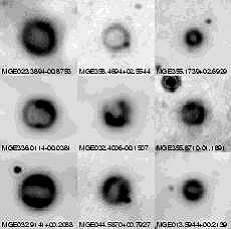It goes by the super-catchy (not!) title “A Catalog of MIPSGAL Disk and Ring Sources”. I chose it, over 213 competitors, because it’s pure astronomy, and because it’s something you don’t need a PhD to be able to do, or even a BSc.
Oh, and also because Don Mizuno and co-authors may have found two, quite local, spiral galaxies that no one has ever seen before!
Some quick background: arXiv has been going for several years now, and provides preprints, on the web, of papers “in the fields of physics, mathematics, non-linear science, computer science, quantitative biology and statistics”. It’s owned, operated and funded by Cornell University. astro-ph is the collection of preprints classified as astro physics; the “recent” category in astro-ph is the new preprints submitted in the last week.
When I have any, one of my favorite spare-time activities is browsing astro-ph (Hey, I did say, in my profile, that I am hooked on astronomy!)
Briefly, what Mizuno and his co-authors did was get hold of some of the images from Spitzer (something that anyone can do, provided their internet connection has enough bandwidth), and eyeball them, looking for things which look like disks and rings. Having found over 400 of them, they did what the human brain does superbly well: they grouped them by similarity of appearance, and gave the groups names. They then checked out other images – from different parts of Spitzer’s archive, and from IRAS – and checked to see how many had already been cataloged.
And what did they find? Well, first, that most of the objects they found had not been cataloged before, and certainly not given definite classifications! Many, perhaps most, of the new objects are planetary nebulae, and their findings may help address a long-standing puzzle in this part of astronomy.


But they also may have found two local spiral galaxies, which had not been noticed before because they are obscured by the gas-and-dust clouds in the Milky Way plane. How cool is that!
Here’s the ‘credits’ section of the preprint: “This work is based on observations made with the Spitzer Space Telescope, which is operated by the Jet Propulsion Laboratory, California Institute of Technology under a contract with NASA. Support for this work was provided by NASA in part through an award issued by JPL/Caltech. This research made use of the SIMBAD database and the Vizier catalog access tool, operated by the Centre de Donnees Astronomique de Strasbourg. This research has also made use of NASA’s Astrophysics Data System Bibliographic Services.”
And here’s the preprint itself: arXiv:1002.4221 A Catalog of MIPSGAL Disk and Ring Sources; D.R. Mizuno(1), K. E. Kraemer(2), N. Flagey(3), N. Billot(4), S. Shenoy(5), R. Paladini(3), E. Ryan(6), A. Noriega-Crespo(3), S. J. Carey(3). ((1) Institute for Scientific Research, (2) Air Force Research Laboratory, (3) Spitzer Science Center, (4) NASA Herschel Science Center, (5) Ames Research Center, (6) University of Minnesota)
PS, going over the Astronomy Cast episode How to be Taken Seriously by Scientists is what motivated me to pick this preprint (however, I must tell you, in all honesty, that there are at least ten other preprints that are equally pickable).


Just goes to show that important work doesn’t necessarily require high-level mathematical skill, big funding and months spent writing observing proposals… Although, these things can help! Some interesting results indeed.
BTW – I think this is a great type of article that you could have on here regularly – a Friday arvo ‘pick of the papers’. I likey very much.
Astrofiend makes a good suggestion (as usual 🙂 )
Jean, check with Nancy about a remarkable paper on little-known or imaged planetary nebulae. I know she’s quite busy at this time (BTW, thanks for the encouraging reply, Nancy! 🙂 ).
Astrofiend, Jon Hanford,
Thanks for your interest and feedback.
The Universe Today readers will decide with their views!
It seems my Universe Puzzle has been well received, so there’ll be a few more of them (a good precedent?)
That space cite that you have Universae Today is from a sci fi book that I think has the title of city of Space.